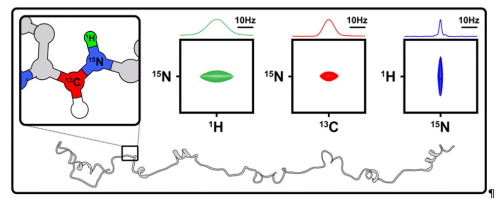Our official English website, www.x-mol.net, welcomes your
feedback! (Note: you will need to create a separate account there.)
Direct Detection of Carbon and Nitrogen Nuclei for High-Resolution Analysis of Intrinsically Disordered Proteins using NMR Spectroscopy
Methods ( IF 4.2 ) Pub Date : 2018-04-01 , DOI: 10.1016/j.ymeth.2018.01.004 E.B. Gibbs , R.W. Kriwacki
Methods ( IF 4.2 ) Pub Date : 2018-04-01 , DOI: 10.1016/j.ymeth.2018.01.004 E.B. Gibbs , R.W. Kriwacki

|
Nuclear magnetic resonance spectroscopy (NMR) is a powerful technique for characterizing the structural and dynamic properties of intrinsically disordered proteins and protein regions (IDPs & IDRs). However, the application of NMR to IDPs has been limited by poor chemical shift dispersion in two-dimensional (2D) 1H-15N heteronuclear correlation spectra. Among the various detection schemes available for heteronuclear correlation spectroscopy, 13C direct-detection has become a mainstay for investigations of IDPs owing to the favorable chemical shift dispersion in 2D 13C'-15N correlation spectra. Recent advances in cryoprobe technology have enhanced the sensitivity for direct detection of both 13C and 15N resonances at high magnetic field strengths, thus prompting the development of 15N direct-detect experiments to complement established 13C-detection experiments. However, the application of 15N-detection has not been widely explored for IDPs. Here we compare 1H, 13C, and 15N detection schemes for a variety of 2D heteronuclear correlation spectra and evaluate their performance on the basis of resolution, chemical shift dispersion, and sensitivity. We performed experiments with a variety of disordered systems ranging in size and complexity; from a small IDR (99 amino acids), to a large low complexity IDR (185 amino acids), and finally a ∼73 kDa folded homopentameric protein that also contains disordered regions (133 amino acids/monomer). We conclude that, while requiring high sample concentration and long acquisition times, 15N-detection often offers enhanced resolution over other detection schemes in studies of disordered protein regions with low complexity sequences.
中文翻译:

使用 NMR 光谱直接检测碳和氮核,用于对固有无序蛋白质进行高分辨率分析
核磁共振波谱 (NMR) 是表征内在无序蛋白质和蛋白质区域 (IDP 和 IDR) 的结构和动态特性的强大技术。然而,由于二维 (2D) 1H-15N 异核相关光谱中化学位移分散性差,NMR 在 IDP 中的应用受到限制。在可用于异核相关光谱的各种检测方案中,13C 直接检测已成为研究 IDP 的主要方法,因为 2D 13C'-15N 相关光谱具有良好的化学位移色散。冷冻探针技术的最新进展提高了在高磁场强度下直接检测 13C 和 15N 共振的灵敏度,因此促进了 15N 直接检测实验的发展,以补充已建立的 13C 检测实验。然而,15N 检测的应用尚未在 IDP 中得到广泛探索。在这里,我们比较了各种 2D 异核相关光谱的 1H、13C 和 15N 检测方案,并根据分辨率、化学位移色散和灵敏度评估了它们的性能。我们对各种规模和复杂性不等的无序系统进行了实验;从一个小的 IDR(99 个氨基酸)到一个大的低复杂性 IDR(185 个氨基酸),最后是一个 ~73 kDa 折叠的同五聚体蛋白,它也包含无序区域(133 个氨基酸/单体)。我们得出的结论是,虽然需要高样品浓度和长采集时间,
更新日期:2018-04-01
中文翻译:

使用 NMR 光谱直接检测碳和氮核,用于对固有无序蛋白质进行高分辨率分析
核磁共振波谱 (NMR) 是表征内在无序蛋白质和蛋白质区域 (IDP 和 IDR) 的结构和动态特性的强大技术。然而,由于二维 (2D) 1H-15N 异核相关光谱中化学位移分散性差,NMR 在 IDP 中的应用受到限制。在可用于异核相关光谱的各种检测方案中,13C 直接检测已成为研究 IDP 的主要方法,因为 2D 13C'-15N 相关光谱具有良好的化学位移色散。冷冻探针技术的最新进展提高了在高磁场强度下直接检测 13C 和 15N 共振的灵敏度,因此促进了 15N 直接检测实验的发展,以补充已建立的 13C 检测实验。然而,15N 检测的应用尚未在 IDP 中得到广泛探索。在这里,我们比较了各种 2D 异核相关光谱的 1H、13C 和 15N 检测方案,并根据分辨率、化学位移色散和灵敏度评估了它们的性能。我们对各种规模和复杂性不等的无序系统进行了实验;从一个小的 IDR(99 个氨基酸)到一个大的低复杂性 IDR(185 个氨基酸),最后是一个 ~73 kDa 折叠的同五聚体蛋白,它也包含无序区域(133 个氨基酸/单体)。我们得出的结论是,虽然需要高样品浓度和长采集时间,











































 京公网安备 11010802027423号
京公网安备 11010802027423号